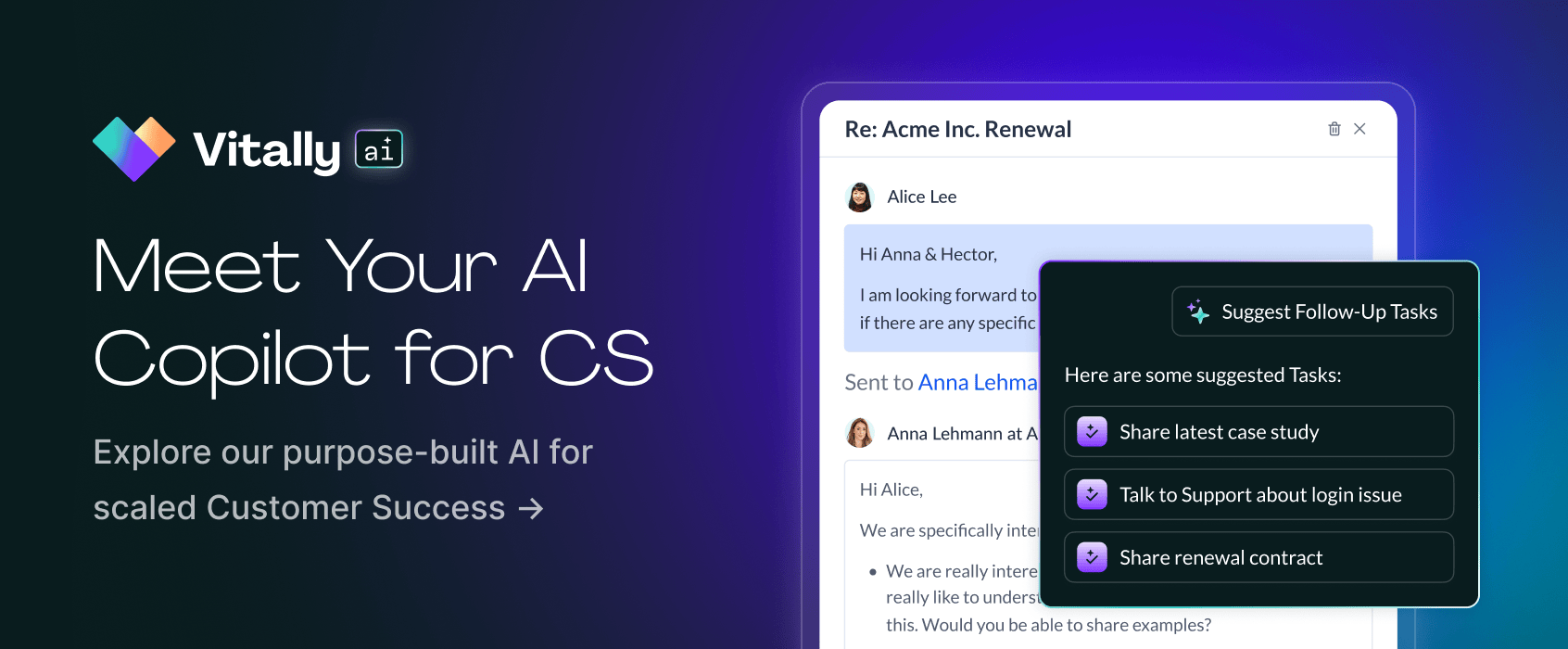
If you rolled your eyes at the sight of this topic, we would understand. Everyone has been talking about AI all year, and frankly, the conversation can be exhausting.
But this isn’t your typical AI article. We won’t tell you AI is eating the world or that we’re going to war with the machines. (Hello, The Matrix 👋) Instead, we have a more nuanced view.
We think every Customer Success team should be exploring how to use AI to improve their workflows and overall productivity. But we know that AI isn’t a silver bullet. It won’t fix a dysfunctional CS operation or overworked CSMs.
Now that we’ve got that out of the way, let’s look at the most exciting AI use-cases we’ve seen for Customer Success, plus two instances where you should never deploy this technology.
The Best Ways That Customer Success Teams Can Use AI
AI tools really shine in two areas:
- Automating boring and repetitive tasks that take up a lot of your time
- Helping you go from zero to one on complex tasks
Some real-world examples of these use cases include:
1. Process Building
“The Customer Success role is very reactive,” explains Mickey Powell, former Head of GTM at UpdateAI. “We react to situations. And then, we build processes to deal with these situations as they recur and become more common.”
A reactive approach to CS can only be sustained for so long, especially with a small team. As your CS operation scales, it gets harder to give each client the attention they need, on top of other time-consuming tasks like hiring, firefighting, and managing a team. That’s when building a CS process becomes essential.
For example, Customer Experience Consultant Craig Stoss uses AI to dramatically shorten the time his customer-facing team spends deciding how to respond to support requests.
"I created an automation with PixieBrix that read in a backlog of Zendesk tickets, and then one by one would send the contents to an AI that could determine the intent and generate a written response based on the knowledge it had been trained on," Craig told us. "Then the human could click the 'accept' button to send the response and close the ticket or they could decide this ticket needed more work on it and mark the ticket as escalated and move to the next one. It was sort of like Tinder swiping, but for support tickets."
AI can also make the documentation of processes more efficient. Scribe, for example, records your screen as you complete certain tasks and turns this into a step-by-step visual guide. This saves the time you would have spent manually putting these materials together from scratch.
2. Team Training
Building your CS process is only one piece of the puzzle. You need to ensure that everyone on your team understands how these processes work and can apply them to their day-to-day tasks.
Every CS leader knows firsthand how expensive it is to train a team, and this is where AI can be pretty helpful. It can cut down the cost and time invested into team training while delivering the same level of output.
For example, Ralphie English, VP of Customer Success at Deepgram, transcribes all of her team’s customer calls with AI to serve as training materials for coaching CSMs and sales teams. Some CS teams convert Scribe’s step-by-step guides into mini-courses for employee training — complete with outlines, takeaways, and interactive exercises — using AI course generators like Heights and Lingio.
Related: How CSP Software Helps You Ramp Up New CSM Hires Faster
3. Customer Onboarding
Customer onboarding is a high-pressure task, even for experienced CSMs. It’s your only chance to make a great first impression and convince the customer that they made the right decision to partner with your organization.
However, there’s no one-size-fits-all approach to onboarding customers. Every customer is different. Even if you have onboarding templates and scripts, you’ll still need to customize them to match each customer’s pain points, preferences, and personality.
Fortunately, AI tools can speed up onboarding customization. Take Vitally’s First Call Success Generator, for example. This tool generates onboarding call briefs based on the customer’s unique business goals. In two minutes or less, you’ll have a document detailing pain points, suggestions for building customer rapport, and other useful tips for a successful first call.
That’s not all. Some CS teams use AI chatbots like ChatGPT to create hyper-personalized onboarding email sequences. Speaking at Matik’s AI + CS Summit, Rod Cherkas, CEO and Founder of HelloCCO, explains how one of his clients pulled this off.
“We wrote a ChatGPT prompt describing the business and what we wanted to achieve. We also provided a description for each weekly email. ChatGPT gave us a pretty shockingly useful outline. And then, for the next step, we asked it to write drafts of the emails.”
Related: Using ChatGPT for Improving Customer Success Productivity
4. Team Collaboration
The CS function touches on other core business operations like sales, product, and engineering. Say a customer has an issue with an app feature; the CSM will work with the engineering team to resolve it.
This means there needs to be a seamless process for exchanging information between the CS team and other cross-functional roles. That’s where AI comes in. These tools can shorten the communication loop between all of your teams for a smoother workflow.
Deepgram, for example, uses AI to make CS-Product collaboration more efficient. “Our product team uses AI software to filter customer calls discussing a specific feature and pull the data they need from those particular calls,” Ralphie English explains.
Related: Introducing Vitally Doc Automation: Seamlessly Create and Assign Collaborative Docs at Scale
5. Personalization
Customers reward businesses for personalized experiences. In fact, more than 50% of participants in Segment’s 2023 State of Personalization Report said they would become repeat buyers after one personalized experience.
But, personalization gets harder as your business scales. It’s easier to track 50 customers’ preferences compared to 5,000 or 10,000 customers. That’s why enterprise companies rely on AI to segment customers and drive personalization and growth.
Glint, for example, used AI to design Guided Experiences, that is white-glove digital experiences that feel personalized at scale.
“We took a lot of the data from our CS system, our support system, and all of our product usage data. And we analyzed it to figure out where the biggest value would be in the human touch along the journey for those digital customers and which activities to surface for them along the journey based on their maturity to help them implement faster, adopt faster, and upsell,” explains Mary Poppen, former Chief Customer Officer at Glint and current President and CCO of HRIZONS Employee Experience.
6. Customer Communication
Communication is one of the most common use cases for AI. CSMs use it to draft emails, respond to customer inquiries, and provide 24/7 support.
But there are more interesting ways to use AI tools in your communication workflow. For example, João Fernandes, CSM at Zendesk, says AI plays a key role in his customer win-back strategy. “I use it for brainstorming ideas on how best to address specific customer personas, especially those who have ghosted or churned.”
Simon Kags, Product Champion and CSM at HeiApply, uses AI to create call summaries for customer follow-ups. “Previously, we reviewed rough notes, typed them out, checked for grammar, and then sent them to our customers. Now, we dictate rough notes into the online dictation tool, copy the output, and paste it into a predesigned GPT that has been trained on our template and product features. The program generates a complete call summary that we can copy, paste, and send.”
The Deepgram team has an even more interesting use case. They developed a large language model (LLM) API that answers product questions using insights from recorded customer conversations across all channels and their knowledge base. This allows the AI to provide updated and contextually relevant responses to customer queries.

What AI Shouldn’t Do For You

Like fire, AI is a good servant but a bad master. Left unchecked, it can have dire consequences for your business and customer experience. That’s why you should never outsource these two things to any AI tool, no matter how awesome it is.
1. End-to-End Customer Success Workflow
The risk factor goes way up as soon as you expose any AI tool to your customers. That’s why you need a human to own your workflow and guide AI use cases.
Mickey Powell explains it best:
“Let’s say I have an internal help center and ask AI to find something, but it returns the wrong information. I’ll be like: It’s okay; I’ll figure it out myself. But if you apply that same use case to the customer and the AI gives them a wrong answer, the consequence is much more dire because the customer doesn't know they're talking to AI. They're guided to the wrong thing, and they won't necessarily know that.”
2. Sensitive Customer Information
Avoid sharing sensitive customer information, such as demographic data and financial records, with third-party AI tools like LLM chatbots.
If you do this, the customer’s data will become a part of the AI’s training set without the customer’s consent, which equates to a breach of trust. On top of that, the customer’s data becomes exposed if the third-party platform gets hacked, which can have tremendous consequences for them and your business.
You can’t stop people on your team from experimenting with AI tools, especially as they are the rave of the moment. But you can set guardrails to ensure they use these tools ethically. We suggest:
- Training your CS team on the capabilities and risks of AI
- Creating AI usage guidelines
- Organizing AI hackathons to test use cases, especially for early adopters
Prioritize Human-First Customer Success
While AI software can speed up different aspects of your interaction with the customer (as we’ve discussed extensively), it should not own all of your CS operations. After all, humans put the “customer” in “Customer Success.”
"I see the current advancements in AI as a productivity enhancer for existing workflows but not as a replacement for much, at least not yet. For now, I would treat it as if it were a new, junior employee — one that needs their work reviewed,” says Vitally’s CEO, Jamie Davidson.
"You can use AI tools to draft emails and content, detect at-risk customers, and perform repetitive tasks. But just like a junior employee, it can and will make mistakes, so give its work a quick review before letting it impact the customer's experience. If used with this mindset, you can optimize almost any task or process with AI, but ensure that it isn't the final step in the process...for now.”
We couldn’t have said it better. Use AI tools to scale your team’s productivity and efficiency as much as possible. But make sure experienced CSMs and CS leaders hold the reins of your Customer Success operations.









